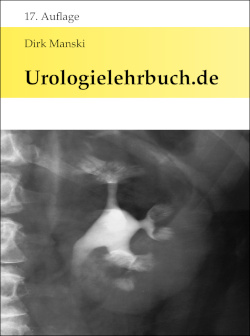Sie sind hier: Startseite > Penis > Peniskarzinom > Chemotherapie und Prognose
Peniskrebs: Chemotherapie und Prognose
- Peniskarzinom: Ursachen und Pathologie
- Penistumor: Klinik und Diagnose
- Peniskarzinom: operative Therapie
- Peniskarzinom: Chemotherapie und Prognose
Chemotherapie bei metastasierten Peniskrebs
Aufgrund der kleinen Fallzahlen in den USA und Europa existieren keine prospektiven randomisierten Studien. Aktuelle Schemata verwenden Kombinationen aus Cisplatin und Taxanen. Das mediane Überlegen liegt bei 9 Monaten, Risikofaktoren für eine schlechte Prognose sind viszerale Metastasen und ein schlechter Allgemeinzustand (Pond u.a., 2014). Während die Immuntherapie mit Checkpoint-Inhibitoren für die Behandlung von Plattenepithelkarzinomen an anderen Lokalisationen etabliert ist, gibt es keine Studien bei Patienten mit einem Peniskarzinom. Einzelne Fallberichte deuten auf ein gutes Ansprechen bei Patienten mit chemotherapierefraktären metastasierten Peniskarzinom hin (Steck u.a., 2021).
Paclitaxel und Cisplatin:
Zyklusdauer 21 Tage, 4 Zyklen bei adjuvanter Anwendung (Noronha u.a., 2012).
- Paclitaxel 175 mg/m2 am Tag 1
- Cisplatin 75 mg/m2 am Tag 1
Taxan, Cisplatin und 5-FU:
(Nicolai u.a., 2015).
- Paclitaxel 120 mg/m2 am Tag 1
- Cisplatin 75 mg/m2 am Tag 1
- 5-Fluorouracil 1000 mg/m2 am Tag 1–5
Paclitaxel, Cisplatin und Ifosfamid:
(Pagliaro u.a., 2010).
- Paclitaxel 175 mg/m2 am Tag 1
- Cisplatin 25 mg/m2 am Tag 1–3
- Ifosfamid 1200 mg/m2 am Tag 1–3
Nachsorge des Peniskarzinoms
Regelmäßige klinische Untersuchung des Penis (nach partieller Penektomie) und der Leistenlymphknoten kann zuverlässig ein Rezidiv erfassen. Die Untersuchungen sollten in den ersten zwei Jahren alle drei Monate erfolgen, danach genügen halbjährliche Kontrollen. Ergänzend kommen die Sonographie (Penis, Leiste, Leber) und die Computertomographie (Abdomen, Becken, Leiste) zum Einsatz, insbesondere bei histologisch nachgewiesenen Lymphknotenmetastasen oder high-grade Tumoren. Die Studienlage hinsichtlich der Bildgebung in der Nachsorge ist dürftig. Bei fortgeschrittener Tumorerkrankung ist ggf. der Tumormarker SCC zur Verlaufskontrolle hilfreich. Das Rezidiv der Erkrankung ist bei nicht durchgeführter Lymphadenektomie v.a. in der Leiste in den ersten 2 Jahren zu erwarten. Ein Lokalrezidiv kann auch viele Jahre nach partieller Penektomie entstehen.
Prognose von Peniskrebs
Prognosefaktoren:
Der Lymphknotenbefall (Anzahl, Lokalisation) ist ein wichtiger prognostischer Faktor. Das Risiko des Lymphknotenbefalls bei T2-Tumoren beträgt um die 50%. Weitere wichtige Prognosefaktoren sind das Grading des Tumors und die Gefäßinvasion.
Lymphknotenbefall:
Der Lymphknotenbefall ist der wichtigste prognostische Faktor. Das Risiko des Lymphknotenbefalls bei T2-Tumoren beträgt um die 50 %, weiterhin ist das Grading des Tumors und die Gefäßinvasion von entscheidender Bedeutung.
pN0:
5JÜR 80 % bis 95 %.
pN+ inguinal:
5JÜR 29 % bis 67 %. Dabei ist die Anzahl der befallenen Lymphknoten entscheidend für die Prognose, 67 % 5JÜR bei 1 oder 2 befallenen Lymphknoten vs. 39 % bei ausgeprägterem Lymphknotenbefall.
pN+ iliakal:
5JÜR 33%.
| Peniskarzinom 3/4 | Suchen | Buschke-Löwenstein-Tumor |
Sachregistersuche: A B C D E F G H I J K L M N O P Q R S T U V W X Y Z
Literatur
O. R. Brouwer, S. T. Tagawa, M. Albersen, B. Ayres, and C. Protzel, “EAU Guidelines: Penile Cancer.” Accessed: 2023. [Online]. Available: https://uroweb.org/guidelines/penile-cancer/
DGU, DKG, AWMF, and L. Onkologie, “S3-Leitlinie Diagnostik, Therapie und Nachsorge des Peniskarzinoms.” Accessed: Aug. 2020. [Online]. Available: https://www.leitlinienprogramm-onkologie.de/leitlinien/peniskarzinom/
Culkin und Beer 2003 CULKIN, D. J. ; BEER,
T. M.:
Advanced penile carcinoma.
In: J Urol
170 (2003), Nr. 2 Pt 1, S. 359–65
Haas u.a. 1999 HAAS, G. P. ; BLUMENSTEIN,
B. A. ; GAGLIANO, R. G. ; RUSSELL, C. A. ; RIVKIN,
S. E. ; CULKIN, D. J. ; WOLF, M. ; CRAWFORD,
E. D.:
Cisplatin, methotrexate and Bleomycin for the treatment of carcinoma
of the penis: a Southwest Oncology Group study.
In: J Urol
161 (1999), Nr. 6, S. 1823–5
Kroon u.a. 2005 KROON, B. K. ; HORENBLAS, S. ;
NIEWEG, O. E.:
Contemporary management of penile squamous cell carcinoma.
In: J Surg Oncol
89 (2005), Nr. 1, S. 43–50
Nicolai, N.; Sangalli, L. M.; Necchi, A.; Giannatempo,
P.; Paganoni, A. M.; Colecchia, M.; Piva, L.; Catanzaro, M. A.; Biasoni,
D.; Stagni, S.; Torelli, T.; Raggi, D.; Faré, E.; Pizzocaro, G. &
Salvioni, R.
A Combination of Cisplatin and 5-Fluorouracil With a
Taxane in Patients Who Underwent Lymph Node Dissection for Nodal
Metastases From Squamous Cell Carcinoma of the Penis: Treatment Outcome
and Survival Analyses in Neoadjuvant and Adjuvant Settings.
Clin
Genitourin Cancer, 2015
Noronha, V.; Patil, V.; Ostwal, V.; Tongaonkar, H.;
Bakshi, G. & Prabhash, K.
Role of paclitaxel and platinum-based
adjuvant chemotherapy in high-risk penile cancer.
Urol Ann, 2012,
4, 150-153
G. R. Pond et al., “Prognostic risk stratification derived from individual patient level data for men with advanced penile squamous cell carcinoma receiving first-line systemic therapy.,” Urologic oncology, vol. 32, no. 4, pp. 501–508, 2014.
Shammas, F. V.; Ous, S. & Fossa, S. D.
Cisplatin
and 5-fluorouracil in advanced cancer of the penis.
J Urol, 1992,
147, 630-632.
S. Steck, W. Went, and D. Kienle, “Profound and durable responses with PD-1 immune checkpoint inhibitors in patients with metastatic penile squamous cell carcinoma,” Curr Probl Cancer, 2021.
 English Version: Diagnosis and treatment of penile cancer
English Version: Diagnosis and treatment of penile cancer
Urologielehrbuch.de ohne Werbung
Diese Internetseite ermöglicht mit Hilfe von Werbung den Volltext-Zugriff auf das aktuelle Urologielehrbuch.de. Viele Bilder sind zum Schutz von Laien verpixelt oder ausgeblendet. Regelmäßig wiederkehrende (fachkundige) Leser können die Werbebanner abschalten und Zugriff auf alle Abbildungen erhalten: Werden Sie Mitglied über die Crowdfunding-Plattform Steady und unterstützen Sie damit Urologielehrbuch.de.
Urologielehrbuch.de als Hardcover-Buch
 Aktuell, detailliert und übersichtlich: Urologielehrbuch.de wird auch als hochwertiges Hardcover-Buch veröffentlicht. Die 17. Auflage (Ausgabe 2024) ist seit Oktober 2024 verfügbar, siehe Abschnitt Neuigkeiten für die Aktualisierungen und Links für den Buchkauf.
Aktuell, detailliert und übersichtlich: Urologielehrbuch.de wird auch als hochwertiges Hardcover-Buch veröffentlicht. Die 17. Auflage (Ausgabe 2024) ist seit Oktober 2024 verfügbar, siehe Abschnitt Neuigkeiten für die Aktualisierungen und Links für den Buchkauf.